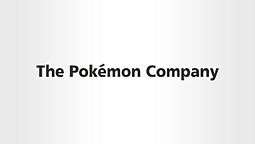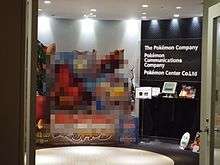The Pokémon Company
 | |
| Joint venture | |
| Founded |
April 23, 1998 Nihonbashi, Tokyo, Japan |
| Headquarters |
Minato, Tokyo, Japan Bellevue, Washington, United States London, United Kingdom Seoul, South Korea |
Key people |
Tsunekazu Ishihara Kenji Okubo |
| Products | Pokémon franchise |
| Services | Brand management |
Number of employees | 400(2016)[1] |
| Parent | |
| Website |
pokemon.co.jp pokemon.jp pokemon.com pokemonkorea.co.kr |

The Pokémon Company (株式会社ポケモン Kabushiki gaisha Pokémon) is a Japanese company that is responsible for marketing and licensing the Pokémon franchise. It was established through a joint investment by the three businesses holding the copyright on Pokémon: Nintendo, Game Freak, and Creatures.[2] It began operating in 1998 and adopted the moniker Pokémon Ltd. in October 2000.[3] The company is headquartered in the Roppongi Hills Mori Tower in Roppongi, Minato, Tokyo.[4]
The company has separate divisions that handle operations in different parts of the world, with The Pokémon Company International supporting the territories outside Asia, Australia, and New Zealand. In South Korea, the operations are handled by Pokémon Korea, Inc.[4]
History
In 1998, Nintendo, Creatures, and Game Freak established The Pokémon Center Company in order to effectively manage the Pokémon Center stores in Japan. After the popularity of Pokémon Gold and Silver, they received many merchandising proposals from around the world. Companies were interested in working with the Pokémon brand. At that time, Tsunekazu Ishihara of Creatures was the person in charge of approving licensed products. Because of the sheer volume of products, Ishihara thought it was too much work for one person to handle. At the same time, in order for the franchise to continue, Ishihara wished to further expand the franchise with long-term goals, such as continuing the anime series and releasing a movie every year. It was then decided that a new organization was needed in order to effectively gather together all the strands of brand management. This led the three companies to turn The Pokémon Center Company into The Pokémon Company and further expand its responsibilities and areas of business. According to Satoru Iwata, establishing The Pokémon Company was one of his first projects at Nintendo.[5]
The United States branch (Pokémon USA, Inc.) opened in 2001 to handle licensing overseas.[6] Nintendo Australia does all licensing and marketing of Pokémon products in Australia and New Zealand, as The Pokémon Company does not have an Australian branch.[4]
Since 2001, nearly all licensed Pokémon products have "©Pokémon" in the copyright acknowledgments with the usual three of "©Nintendo", "©GAME FREAK inc." and "©Creatures Inc." Despite this, Nintendo is the sole owner of the Pokémon trademark.[7] The video games, Pokémon Trading Card Game and licensed toys are still being made by third- and second-party companies such as Tomy.
In October 2001, 4Kids Entertainment (now know as 4Licensing Corporation) acquired a 3% stake in The Pokémon Company for an undisclosed sum.[8][9] They liquidated this stake 4 years later for US$960,000.[10]
In 2006, Pokémon Korea, Inc. was founded to manage the company's operations in South Korea.[6] Its headquarters are located in Seoul.[11]
In 2009, Pokémon USA and Pokémon UK merged to become The Pokémon Company International, which handles American and European Pokémon operations under the administration of Kenji Okubo.[12] The company's offices in the United States are in Bellevue, Washington[13] and its offices in the United Kingdom are in London.[4] Australian operations are controlled by Nintendo Australia.
Retail sales
| Year | The Pokémon Company |
|---|---|
| 2007[14] | 1.4 |
| 2008[15] | 1.4 |
| 2009[16] | 1.4 |
| 2010[17] | 2.5 |
| 2011[18] | 1.5 |
| 2012[19] | 1.6 |
| 2013[20] | 1.5 |
| 2014[21] | 2 |
| 2015[22] | 2.1 |
List of works
Games
Anime
References
- ↑ "Updated list of employee counts for Nintendo companies". nintendoeverything.com. July 1, 2016. Retrieved September 11, 2016.
- 1 2 "Company History". The Pokemon Company.
- ↑ "Company History - The Pokémon Company". Pokemon.com. Retrieved 2016-03-06.
- 1 2 3 4 "会社概要". The Pokémon Company. Retrieved 31 August 2014.
- ↑ "Iwata Asks".
- 1 2 "沿革". The Pokémon Company. Retrieved 31 August 2014.
- ↑ "Legal Information". The Pokémon Company. Retrieved 4 August 2016.
- ↑ "4Kids Entertainment Signs New Five-Year Agreement With Pokemon USA/Leading Children's Entertainment Company Acquires 3% Interest In The Pokemon Company". thefreelibrary.com. October 10, 2001. Retrieved July 16, 2016.
- ↑ "4Kids Entertainment Signs New Five-Year Agreement With Pokémon USA" (PDF). 4kidsentertainment.com. October 10, 2001. Archived from the original (PDF) on October 24, 2005. Retrieved July 29, 2016.
- ↑ "Form 10K". EdgarOnline.com. March 16, 2006. Retrieved July 16, 2016.
- ↑ Jones, Adams (11 August 2016). "Pokethrift Pokemon Go: Accounts and technical issues". pokethrift.com. Pokethrift. Retrieved 19 September 2016.
organization to provide a LIFETIME WARRANTY on all of accounts.
- ↑ Daswani, Mansha (9 April 2009). "Pokémon Merges North American, European Operations". WorldScreen.com.com. Archived from the original on 13 April 2009. Retrieved 17 May 2013.
- ↑ "Contact Us". The Pokémon Company International. Retrieved 31 August 2014.
- ↑ "TOP 100 Licensors". licensemag.com. Retrieved July 16, 2016.
- ↑ "Top 100 Global Licensors". licensemag.com. Retrieved July 16, 2016.
- ↑ "TOP 125 Global Licensors". licensemag.com. Retrieved July 16, 2016.
- ↑ "TOP 125". licensemag.com. Retrieved July 16, 2016.
- ↑ "Top 125 Global Licensors". licensemag.com. Retrieved July 16, 2016.
- ↑ "Top 150 Global Licensors". licensemag.com. Retrieved July 16, 2016.
- ↑ "The Top 150 Global Licensors". licensemag.com. Retrieved July 16, 2016.
- ↑ "The Top 150 Global Licensors". licensemag.com. Retrieved July 16, 2016.
- ↑ "The Top 150 Global Licensors". licensemag.com. Retrieved July 16, 2016.